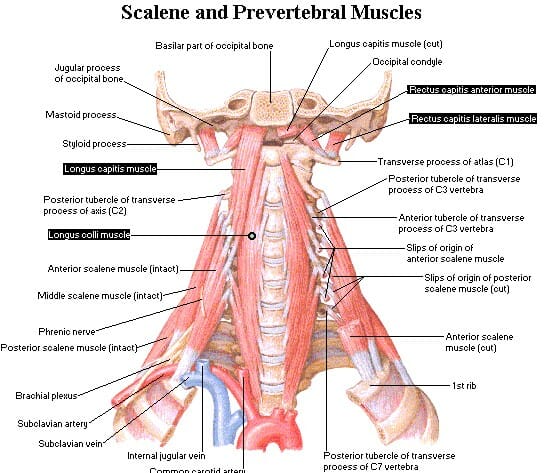How to treat neck pain with Deep Neck Flexor training
Have neck pain? Can’t shake that muscle tightness in your neck? Work on those Deep Neck Flexors!
A common problem in today’s society is poor posture. The evolution of the cellphone and laptop is a primary contributor to this issue and is most likely the cause of an increase in people with neck related pain.
Your deep neck flexors (DNF) provide stability in your neck due to their origin and insertion in the human body. They sit close to your vertebrae in the neck and are short in length. Longus colli and Longus cervicis are the main DNF. You can think of them as the “core” of the neck.

When your head sits in a forward head position, your DNF become weak and inhibited. This causes other muscles (Sternocleidomastoid-SCM, Scalene, Upper traps and Levator scapulae) in your neck to compensate by increasing the amount of work they have to do to stabilize the neck. This compensation causes these other muscles to increase in tone and could be why you constantly feel tight even though you “stretch” your neck muscles. When any part of your body decreases in stability, surrounding muscles have to increase their work to provide adequate stability so your body doesn’t fall apart! In these situation you need to increase stability in this area rather than stretch muscles in order for pain and tightness to decrease. Research has shown that improving your DNF strength can help decrease pain, decrease headaches, and improve ROM in the neck
A simple exercise to work on your DNF
- Lie on your back with knees comfortably bent. Find your neutral spine position. Use a small rolled towel under the head if needed.
- Lift your head off the towel and feel the superficial muscles on the front of the neck. These are NOT the deep neck flexor muscles – these muscles (SCM and scalene are often overworked to try and help with stability, they are not designed for this purpose.)
- Perform a chin tuck towards the middle of your throat, as if to look towards your toes. Don’t lift your head up. You should not feel the muscles on the front of the neck moving, but rather you should be using the muscles deep behind them. It is a very subtle movement!
- Hold for 5 seconds. Repeat 10 times. 2-3 x a day
Evidence
-
Chiu TT, Lam TH, Hedley AJ. A randomized controlled trial on the efficacy of exercise for patients with chronic neck pain. Spine. 2005; 30(1): E1–E7.
-
Jull G, O’leary S, Falla D. Clinical assessment of the deep cervical flexor muscles: the craniocervical flexion test. Journal of Manipulative and Physiological Therapeutics. 2008; 31: 525-33.
-
Jull G, Barrett C, Magee R, Ho P. Further clinical clarification of the muscle dysfunction in cervical headache. Cephalalgia 1999; 19: 179–85.
Related information on neck pain treatments
-
Dry Needling for Neck Pain
-
Headaches & Chiropractic Treatment
-
Motor vehicle accidents and whiplash: How Chiropractic can help
-
Upper Cross Syndrome – Pains of an Office Worker
Visit our Physio Clinic in Burnaby BC
This blog is written by Robbi Basran, Physiotherapist who is FMS and SFMA certified at our Burnaby Physiotherapy Clinic.
If you are interested in booking an appointment with Robbi, please contact our Burnaby Physiotherapy Clinic at 604-558-2273 and he would be happy to see you.
